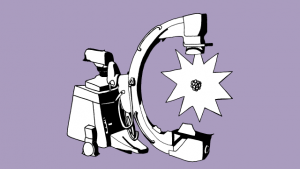Ever since Wilhelm Röntgen photographed the inside of his wife’s hand in 1896, the imaging power of X-rays has been providing us with sights hidden from the naked eye. Their penetrating power allows us to peer deep inside all manner of objects, with X-ray scanners now appearing in places as varied as airports, hospitals, and art galleries.
However, the nanometre (one billionth of a metre) wavelength of X-rays also allows scientists to look at objects far too small to be seen with conventional microscopes. Through the development of X-ray crystallography in the early twentieth century, the atomic structure of crystals was revealed. As the technique matured, it allowed for the imaging of far more complicated structures such as DNA.
As the name suggests, crystallography requires crystals, where the repetition of atoms is key to the entire process. These atoms in a crystal scatter X-rays, which then form characteristic ‘diffraction patterns’. The regular lattice of the crystal reinforces the diffracted X-rays, strengthening the pattern, the details of which encode information about the structure and chemical composition of the crystal. To date, crystallography has imaged tens of thousands of crystalline protein structures, including important molecules such as insulin. Knowing the atomic arrangement of these tiny objects is crucial to understanding how they function, which is essential for developing new drugs and treatments.
Sadly not everything can be made into crystals, meaning that the exact form of many important biological entities remains elusive. Furthermore, the process of crystallisation can damage biological matter, in which case the images obtained are inaccurate representations of the molecules themselves.
Now scientists are finding ways around these limitations using ultra-short bursts of X-rays to record diffraction patterns from single molecules. These techniques capture complete structures instantly without the need for crystals. However, without a crystalline structure, we no longer have a regular lattice to reinforce the diffraction. As a result, to image an individual molecule cleanly and with enough detail, an extremely high dose of X-rays is required. This dose is so high, in fact, that it quickly destroys the object under scrutiny. But, if the X-ray pulse is short enough, it can pass through before the molecule has time to explode, producing a clear diffraction pattern.
Biological bodies explode within tens of femtoseconds (ten million billionths of a second). While short pulse X-ray sources have been around for some time, it was only at the beginning of this century that short enough pulses with sufficient intensity became available, with the advent of the X-ray free-electron laser. These enormous machines use large arrays of powerful magnets called undulators to wiggle pulses of electrons side-to-side very rapidly. These oscillations cause the electrons to emit radiation with exceedingly high intensities in femtosecond bursts.
The first realisation of ‘diffraction before destruction’ came in 2006, when images were recovered from a single 25-femtosecond free-electron laser shot. The object—a nanometre-sized etching on a silicon nitride membrane—was placed into the X-ray beam, which passed through it so quickly that the image obtained showed no distortion at all, even though the object was completely destroyed by the process.
This remarkable achievement was followed a year later by snapshots (with femtosecond exposure times)of nanometre-scale silicon spheres exploding. In this experiment, X-rays pass through the sphere, initiating an explosion, and are reflected back by a mirror through the bursting ball, capturing its instantaneous structure. Between exposures, the reflecting mirror is moved by a tiny amount. Subsequently, the pulse takes longer to return to the sphere, which has now expanded a little more, allowing another step in the explosion to be recorded. The whole process is repeated many times, creating a series of images charting the detailed destruction of the ball.
With these preliminary ‘proof-of-principle’ experiments complete, the stage is set for further exciting investigations into many biological and chemical substances, previously inaccessible using other imaging methods. Last ast year, the Chapman group from the University of Hamburg presented work which used this technique to image Photosystem I, an important protein for photosynthesis, in full 3D.
These ‘snapshot’ techniques will monitor fundamental processes—such as protein folding—as they happen, producing high-resolution images on the timescale of biological activity. As these technologies become more sophisticated, the possibilities for understanding the microscopic world are growing larger than ever before.
Nicky Dean has just completed a DPhil in Physics, using ultrashort laser sources to study electronic and structural dynamics in different materials.
Art by Inez Januszczak.
![Imaging in a Flash Ever since Wilhelm Röntgen photographed the inside of his wife’s hand in 1896, the imaging power of X-rays has been providing us with sights hidden […]](/wp-content/uploads/2011/10/Imaging-in-a-flash_preview-620x300.png)
